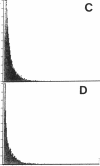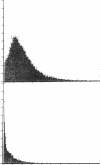Abstract
A patient presenting delayed umbilical cord detachment, severe recurrent bacterial infections, and inability to form pus exhibited a profound defect in the expression of alpha- and beta-chains of the receptor for the C3bi fragment of C3 (CR3), lymphocyte function antigen 1 (LFA-1) molecule, and the p150,95 molecule found on neutrophils, monocytes, and lymphocyte membranes. This was shown by immunofluorescence studies using specific monoclonal antibodies, rosette formation with C3bi-coated erythrocytes, and immunoprecipitation for the LFA-1 complex. These membrane defects were responsible for abnormal phagocytic cell functions including adherence to nylon wool, cell movement, phagocytosis, and opsonized particle-induced oxidative response and for defective natural killer cell activity. In addition, lymphocyte function deficiencies previously unobserved in this disease were found. Cytolytic T lymphocyte activity was profoundly reduced; alpha- and gamma-interferon production were impaired. Finally, there was no antibody production to vaccinal antigens whereas the antibody responses to polysaccharides and to cytomegalovirus were found to be normal. The cytotoxic T cell deficiency could be expected from previous blocking experiments of this function with monoclonal antibodies to LFA-1 and is probably related to an extremely severe deficiency in LFA-1 expression in this patient. Anomalies in interferon and in antibody production suggest additional role(s) of the LFA-1 complex in monocyte/T lymphocyte/B lymphocyte cell interactions that have not yet been envisaged.
Full text
PDF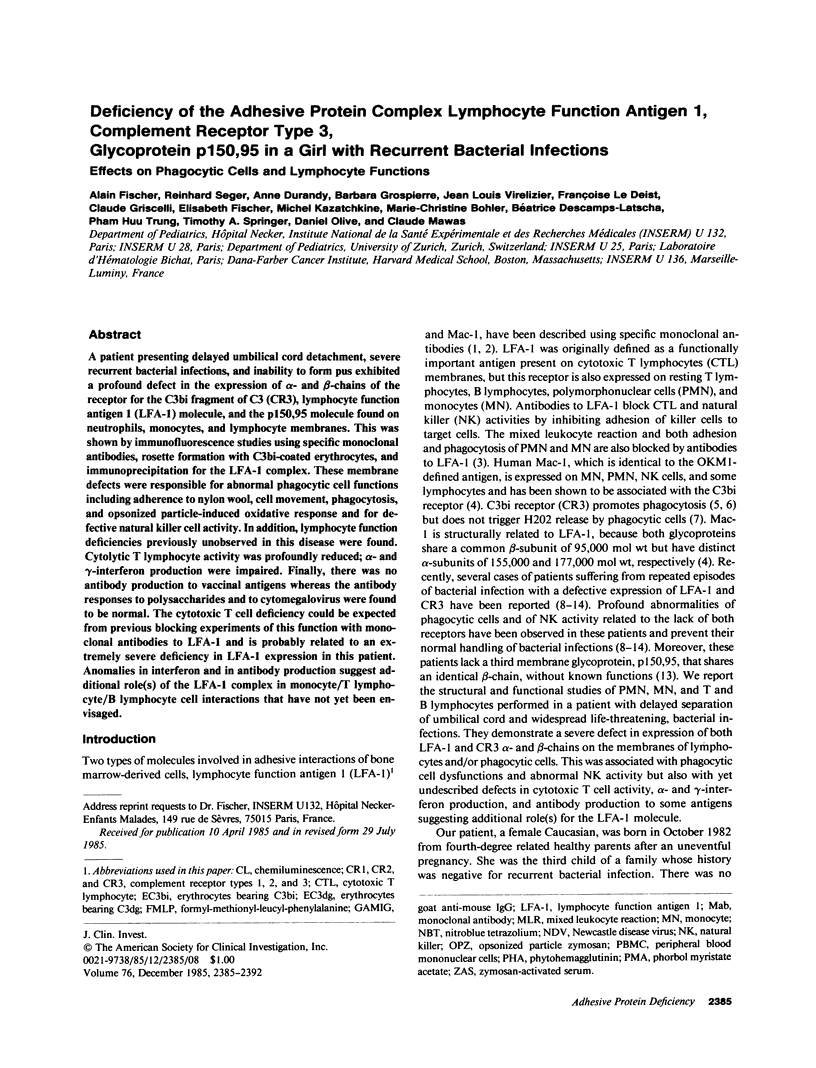
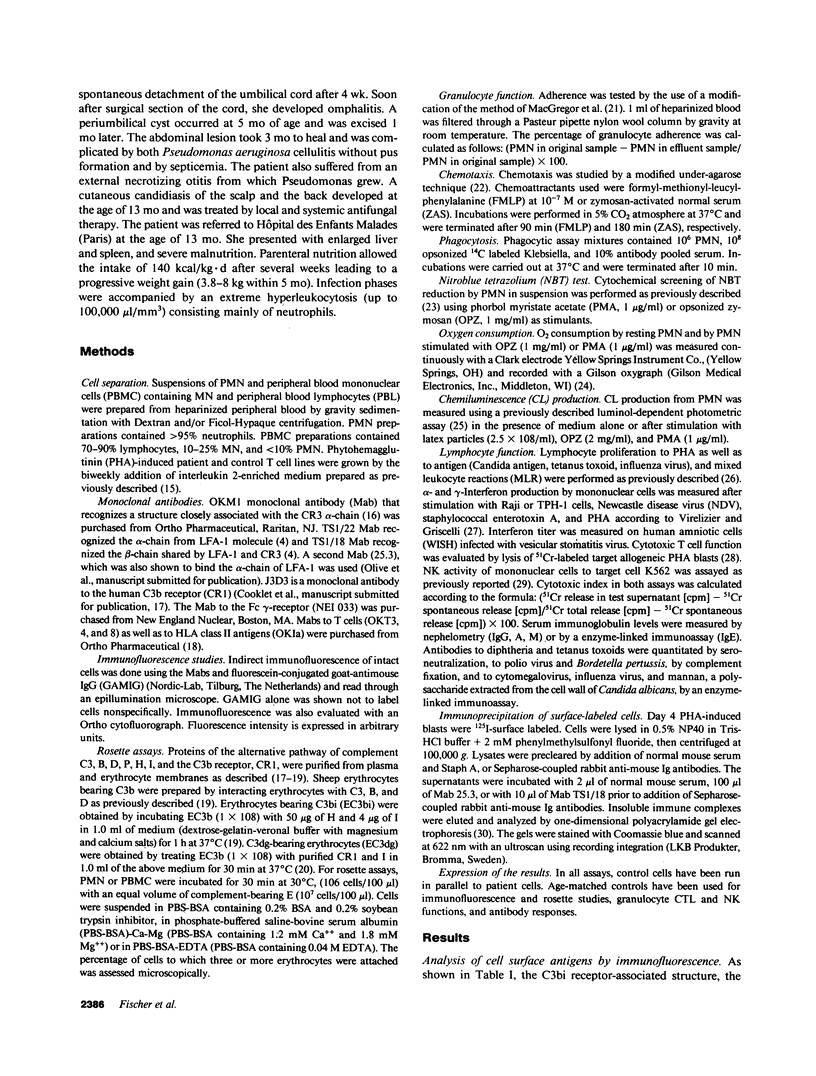
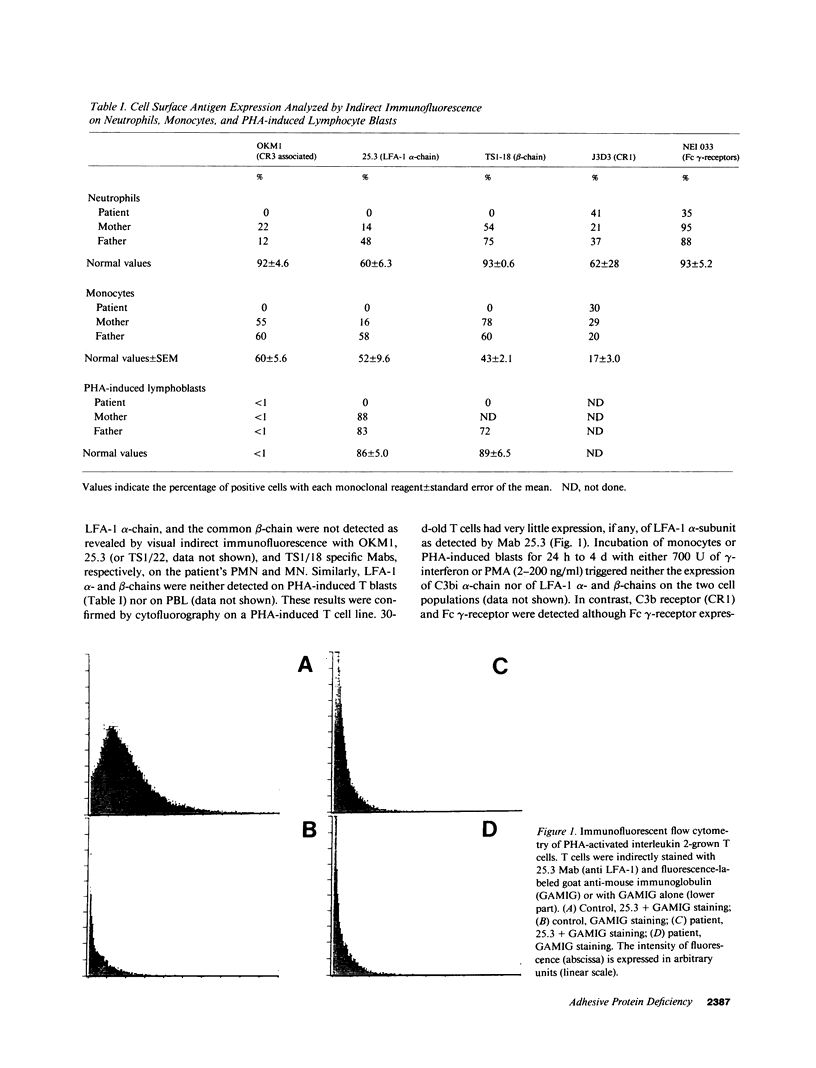
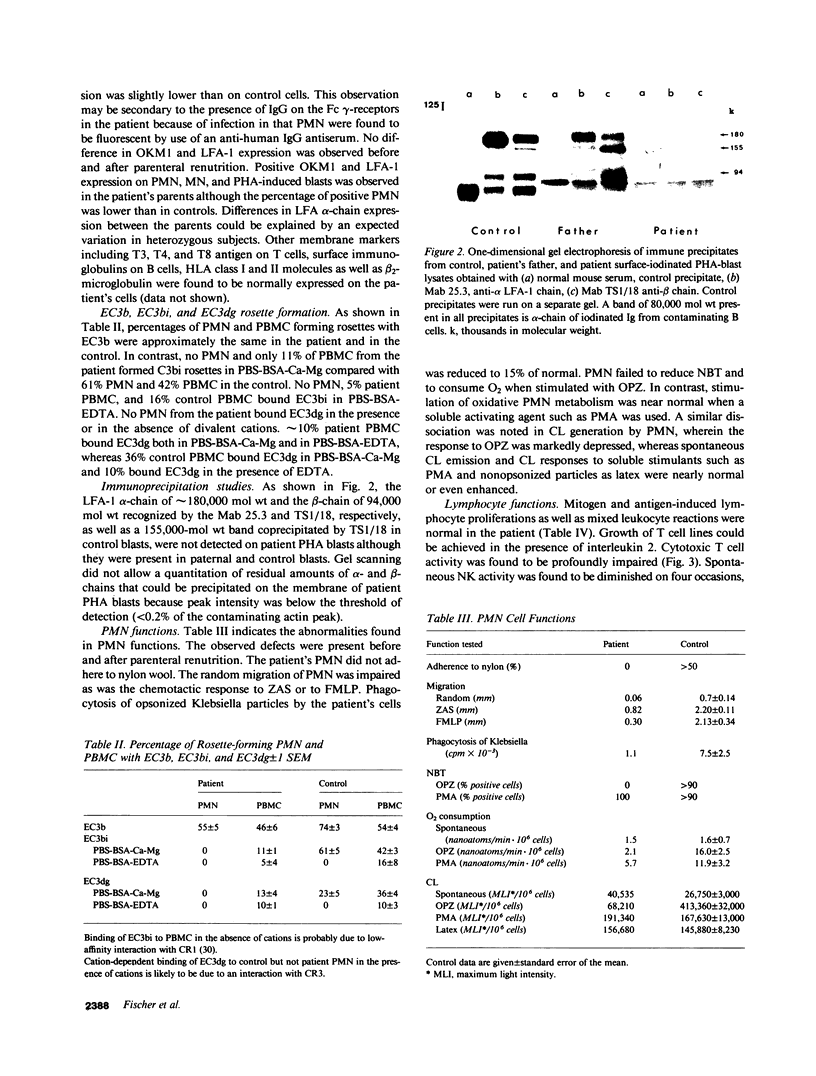
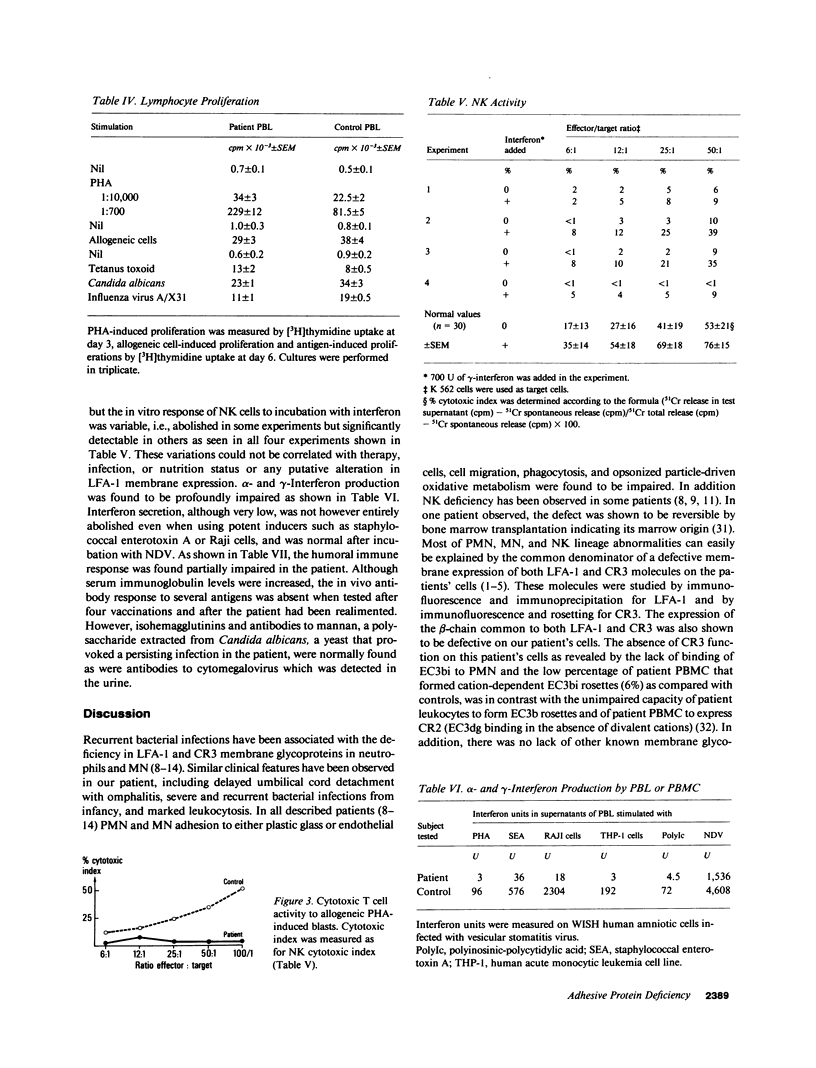
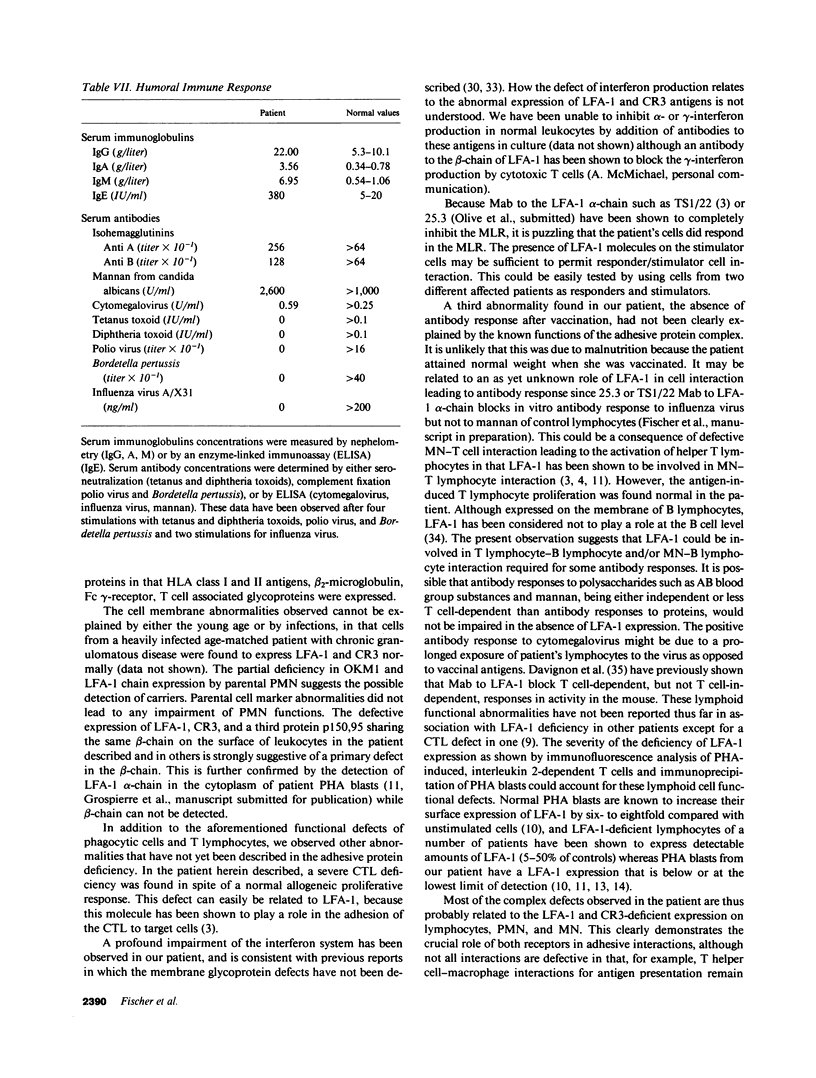
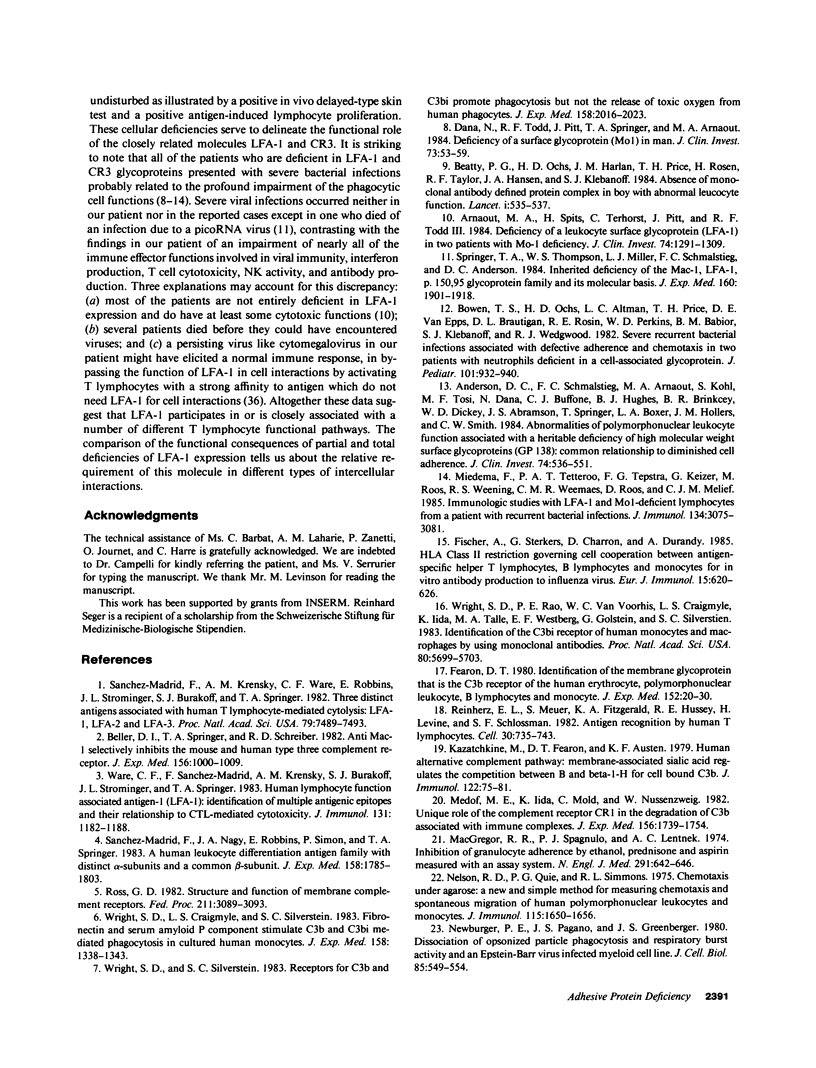
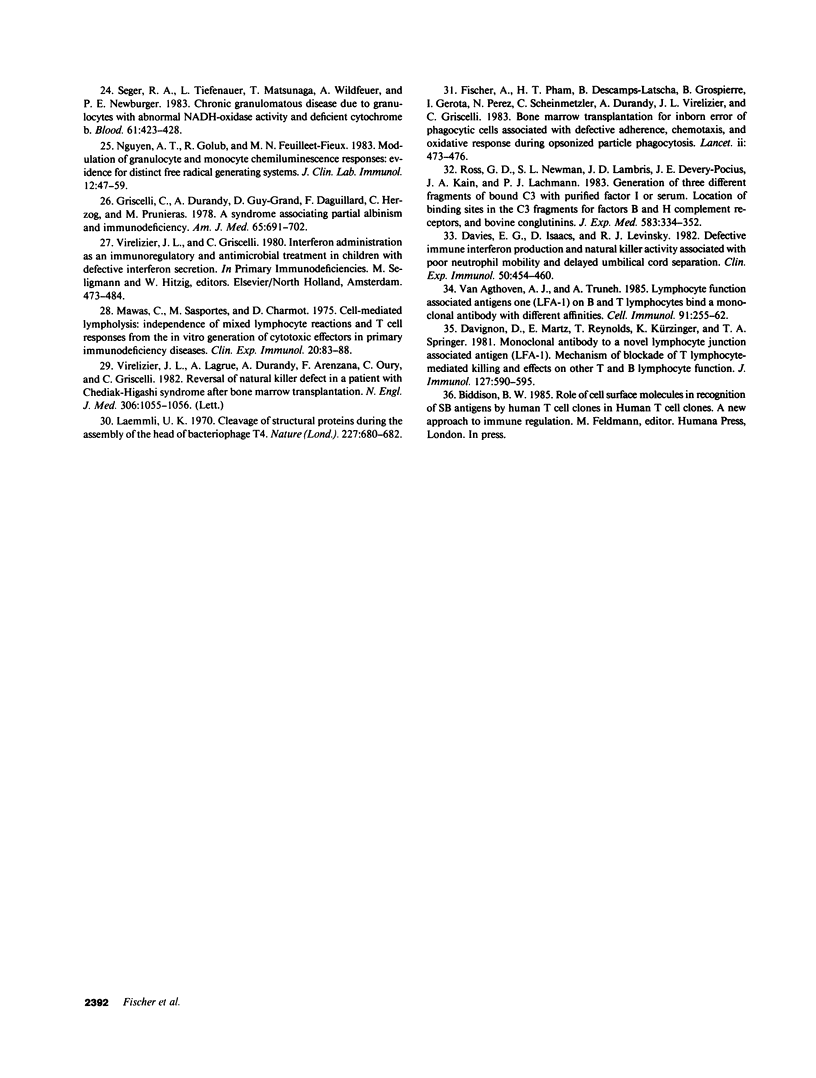
Images in this article
Selected References
These references are in PubMed. This may not be the complete list of references from this article.
- Anderson D. C., Schmalstieg F. C., Arnaout M. A., Kohl S., Tosi M. F., Dana N., Buffone G. J., Hughes B. J., Brinkley B. R., Dickey W. D. Abnormalities of polymorphonuclear leukocyte function associated with a heritable deficiency of high molecular weight surface glycoproteins (GP138): common relationship to diminished cell adherence. J Clin Invest. 1984 Aug;74(2):536–551. doi: 10.1172/JCI111451. [DOI] [PMC free article] [PubMed] [Google Scholar]
- Arnaout M. A., Spits H., Terhorst C., Pitt J., Todd R. F., 3rd Deficiency of a leukocyte surface glycoprotein (LFA-1) in two patients with Mo1 deficiency. Effects of cell activation on Mo1/LFA-1 surface expression in normal and deficient leukocytes. J Clin Invest. 1984 Oct;74(4):1291–1300. doi: 10.1172/JCI111539. [DOI] [PMC free article] [PubMed] [Google Scholar]
- Beatty P. G., Ochs H. D., Harlan J. M., Price T. H., Rosen H., Taylor R. F., Hansen J. A., Klebanoff S. J. Absence of monoclonal-antibody-defined protein complex in boy with abnormal leucocyte function. Lancet. 1984 Mar 10;1(8376):535–537. doi: 10.1016/s0140-6736(84)90933-4. [DOI] [PubMed] [Google Scholar]
- Beller D. I., Springer T. A., Schreiber R. D. Anti-Mac-1 selectively inhibits the mouse and human type three complement receptor. J Exp Med. 1982 Oct 1;156(4):1000–1009. doi: 10.1084/jem.156.4.1000. [DOI] [PMC free article] [PubMed] [Google Scholar]
- Bowen T. J., Ochs H. D., Altman L. C., Price T. H., Van Epps D. E., Brautigan D. L., Rosin R. E., Perkins W. D., Babior B. M., Klebanoff S. J. Severe recurrent bacterial infections associated with defective adherence and chemotaxis in two patients with neutrophils deficient in a cell-associated glycoprotein. J Pediatr. 1982 Dec;101(6):932–940. doi: 10.1016/s0022-3476(82)80013-9. [DOI] [PubMed] [Google Scholar]
- Davies E. G., Isaacs D., Levinsky R. J. Defective immune interferon production and natural killer activity associated with poor neutrophil mobility and delayed umbilical cord separation. Clin Exp Immunol. 1982 Nov;50(2):454–460. [PMC free article] [PubMed] [Google Scholar]
- Davignon D., Martz E., Reynolds T., Kürzinger K., Springer T. A. Monoclonal antibody to a novel lymphocyte function-associated antigen (LFA-1): mechanism of blockade of T lymphocyte-mediated killing and effects on other T and B lymphocyte functions. J Immunol. 1981 Aug;127(2):590–595. [PubMed] [Google Scholar]
- Fearon D. T. Identification of the membrane glycoprotein that is the C3b receptor of the human erythrocyte, polymorphonuclear leukocyte, B lymphocyte, and monocyte. J Exp Med. 1980 Jul 1;152(1):20–30. doi: 10.1084/jem.152.1.20. [DOI] [PMC free article] [PubMed] [Google Scholar]
- Fischer A., Sterkers G., Charron D., Durandy A. HLA class II restriction governing cell cooperation between antigen-specific helper T lymphocytes, B lymphocytes and monocytes for in vitro antibody production to influenza virus. Eur J Immunol. 1985 Jun;15(6):620–626. doi: 10.1002/eji.1830150617. [DOI] [PubMed] [Google Scholar]
- Fischer A., Trung P. H., Descamps-Latscha B., Lisowska-Grospierre B., Gerota I., Perez N., Scheinmetzler C., Durandy A., Virelizier J. L., Griscelli C. Bone-marrow transplantation for inborn error of phagocytic cells associated with defective adherence, chemotaxis, and oxidative response during opsonised particle phagocytosis. Lancet. 1983 Aug 27;2(8348):473–476. doi: 10.1016/s0140-6736(83)90509-3. [DOI] [PubMed] [Google Scholar]
- Griscelli C., Durandy A., Guy-Grand D., Daguillard F., Herzog C., Prunieras M. A syndrome associating partial albinism and immunodeficiency. Am J Med. 1978 Oct;65(4):691–702. doi: 10.1016/0002-9343(78)90858-6. [DOI] [PubMed] [Google Scholar]
- Kazatchkine M. D., Fearon D. T., Austen K. F. Human alternative complement pathway: membrane-associated sialic acid regulates the competition between B and beta1 H for cell-bound C3b. J Immunol. 1979 Jan;122(1):75–81. [PubMed] [Google Scholar]
- Laemmli U. K. Cleavage of structural proteins during the assembly of the head of bacteriophage T4. Nature. 1970 Aug 15;227(5259):680–685. doi: 10.1038/227680a0. [DOI] [PubMed] [Google Scholar]
- Lipsky P. E. Immunosuppression by D-penicillamine in vitro. Inhibition of human T lymphocyte proliferation by copper- or ceruloplasmin-dependent generation of hydrogen peroxide and protection by monocytes. J Clin Invest. 1984 Jan;73(1):53–65. doi: 10.1172/JCI111207. [DOI] [PMC free article] [PubMed] [Google Scholar]
- MacGregor R. R., Spagnuolo P. J., Lentnek A. L. Inhibition of granulocyte adherence by ethanol, prednisone, and aspirin, measured with an assay system. N Engl J Med. 1974 Sep 26;291(13):642–646. doi: 10.1056/NEJM197409262911302. [DOI] [PubMed] [Google Scholar]
- Mawas C., Sasportes M., Charmot D., Christen Y., Dausset J. Cell-mediated lympholysis in vitro. Independence of mixed lymphocyte reactions and T-cell mitogen responses from the in vitro generation of cytotoxic effectors in primary immunodeficiency diseases. Clin Exp Immunol. 1975 Apr;20(1):83–92. [PMC free article] [PubMed] [Google Scholar]
- Medof M. E., Iida K., Mold C., Nussenzweig V. Unique role of the complement receptor CR1 in the degradation of C3b associated with immune complexes. J Exp Med. 1982 Dec 1;156(6):1739–1754. doi: 10.1084/jem.156.6.1739. [DOI] [PMC free article] [PubMed] [Google Scholar]
- Miedema F., Tetteroo P. A., Terpstra F. G., Keizer G., Roos M., Weening R. S., Weemaes C. M., Roos D., Melief C. J. Immunologic studies with LFA-1- and Mo1-deficient lymphocytes from a patient with recurrent bacterial infections. J Immunol. 1985 May;134(5):3075–3081. [PubMed] [Google Scholar]
- Nelson R. D., Quie P. G., Simmons R. L. Chemotaxis under agarose: a new and simple method for measuring chemotaxis and spontaneous migration of human polymorphonuclear leukocytes and monocytes. J Immunol. 1975 Dec;115(6):1650–1656. [PubMed] [Google Scholar]
- Newburger P. E., Pagano J. S., Greenberger J. S., Karpas A., Cohen H. J. Dissociation of opsonized particle phagocytosis and respiratory burst activity in an Epstein-Barr virus-infected myeloid cell line. J Cell Biol. 1980 Jun;85(3):549–557. doi: 10.1083/jcb.85.3.549. [DOI] [PMC free article] [PubMed] [Google Scholar]
- Nguyen A. T., Golub R., Feuillet-Fieux M. N., Descamps-Latscha B. Modulation of human granulocyte and monocyte chemiluminescence responses: evidence for distinct free radical generating systems. J Clin Lab Immunol. 1983 Sep;12(1):47–55. [PubMed] [Google Scholar]
- Reinherz E. L., Meuer S., Fitzgerald K. A., Hussey R. E., Levine H., Schlossman S. F. Antigen recognition by human T lymphocytes is linked to surface expression of the T3 molecular complex. Cell. 1982 Oct;30(3):735–743. doi: 10.1016/0092-8674(82)90278-1. [DOI] [PubMed] [Google Scholar]
- Ross G. D., Newman S. L., Lambris J. D., Devery-Pocius J. E., Cain J. A., Lachmann P. J. Generation of three different fragments of bound C3 with purified factor I or serum. II. Location of binding sites in the C3 fragments for factors B and H, complement receptors, and bovine conglutinin. J Exp Med. 1983 Aug 1;158(2):334–352. doi: 10.1084/jem.158.2.334. [DOI] [PMC free article] [PubMed] [Google Scholar]
- Ross G. D. Structure and function of membrane complement receptors. Summary. Fed Proc. 1982 Dec;41(14):3089–3093. [PubMed] [Google Scholar]
- Sanchez-Madrid F., Krensky A. M., Ware C. F., Robbins E., Strominger J. L., Burakoff S. J., Springer T. A. Three distinct antigens associated with human T-lymphocyte-mediated cytolysis: LFA-1, LFA-2, and LFA-3. Proc Natl Acad Sci U S A. 1982 Dec;79(23):7489–7493. doi: 10.1073/pnas.79.23.7489. [DOI] [PMC free article] [PubMed] [Google Scholar]
- Sanchez-Madrid F., Nagy J. A., Robbins E., Simon P., Springer T. A. A human leukocyte differentiation antigen family with distinct alpha-subunits and a common beta-subunit: the lymphocyte function-associated antigen (LFA-1), the C3bi complement receptor (OKM1/Mac-1), and the p150,95 molecule. J Exp Med. 1983 Dec 1;158(6):1785–1803. doi: 10.1084/jem.158.6.1785. [DOI] [PMC free article] [PubMed] [Google Scholar]
- Seger R. A., Tiefenauer L., Matsunaga T., Wildfeuer A., Newburger P. E. Chronic granulomatous disease due to granulocytes with abnormal NADPH oxidase activity and deficient cytochrome-b. Blood. 1983 Mar;61(3):423–428. [PubMed] [Google Scholar]
- Springer T. A., Thompson W. S., Miller L. J., Schmalstieg F. C., Anderson D. C. Inherited deficiency of the Mac-1, LFA-1, p150,95 glycoprotein family and its molecular basis. J Exp Med. 1984 Dec 1;160(6):1901–1918. doi: 10.1084/jem.160.6.1901. [DOI] [PMC free article] [PubMed] [Google Scholar]
- Virelizier J. L., Lagrue A., Durandy A., Arenzana F., Oury C., Griscelli C., Reinert P. Reversal of natural killer defect in a patient with Chédiak-Higashi syndrome after bone-marrow transplantation. N Engl J Med. 1982 Apr 29;306(17):1055–1056. doi: 10.1056/nejm198204293061718. [DOI] [PubMed] [Google Scholar]
- Ware C. F., Sanchez-Madrid F., Krensky A. M., Burakoff S. J., Strominger J. L., Springer T. A. Human lymphocyte function associated antigen-1 (LFA-1): identification of multiple antigenic epitopes and their relationship to CTL-mediated cytotoxicity. J Immunol. 1983 Sep;131(3):1182–1188. [PubMed] [Google Scholar]
- Wright S. D., Craigmyle L. S., Silverstein S. C. Fibronectin and serum amyloid P component stimulate C3b- and C3bi-mediated phagocytosis in cultured human monocytes. J Exp Med. 1983 Oct 1;158(4):1338–1343. doi: 10.1084/jem.158.4.1338. [DOI] [PMC free article] [PubMed] [Google Scholar]
- Wright S. D., Rao P. E., Van Voorhis W. C., Craigmyle L. S., Iida K., Talle M. A., Westberg E. F., Goldstein G., Silverstein S. C. Identification of the C3bi receptor of human monocytes and macrophages by using monoclonal antibodies. Proc Natl Acad Sci U S A. 1983 Sep;80(18):5699–5703. doi: 10.1073/pnas.80.18.5699. [DOI] [PMC free article] [PubMed] [Google Scholar]
- Wright S. D., Silverstein S. C. Receptors for C3b and C3bi promote phagocytosis but not the release of toxic oxygen from human phagocytes. J Exp Med. 1983 Dec 1;158(6):2016–2023. doi: 10.1084/jem.158.6.2016. [DOI] [PMC free article] [PubMed] [Google Scholar]
- van Agthoven A. J., Truneh A. Lymphocyte function-associated antigens one (LFA-1) on B and on T lymphocytes bind a monoclonal antibody with different affinities. Cell Immunol. 1985 Mar;91(1):255–262. doi: 10.1016/0008-8749(85)90048-6. [DOI] [PubMed] [Google Scholar]



